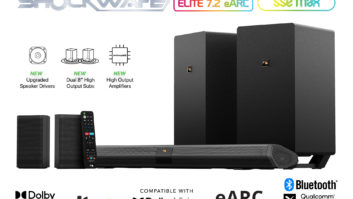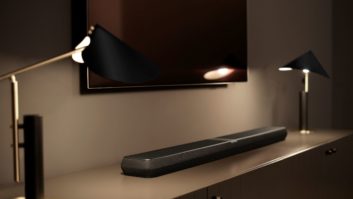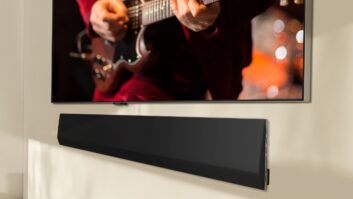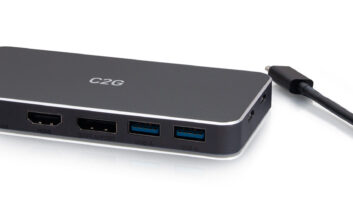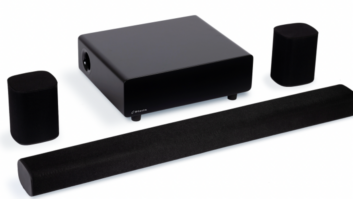
To paraphrase Michael Corleone, “Just when I thought I was out, some new soundbar pulls me back in!” Soundbars weren’t always an exciting product category, but rather something often looked down on and offered as a pitiful last resort. But manufacturers have so steadily upped their soundbar game, they now offer installers and end-users plenty of great options and solutions when a traditional surround system won’t do for whatever reason, with performance that can by cinematic and immersive.
Recently I’ve reviewed Savant’s Smart Series WiSA surround system, Sonos’ Arc Atmos bar, Sony’s Z9F Atmos bar, and Sennheiser’s AMBEO soundbar. While totally different designs, features, and price points, they all had their own unique strengths and reasons to consider selling.
At CES this past January, LG demonstrated its new SN11RG soundbar that was so impressive, I started haranguing their PR team for a review sample straight away. The SN11RG is LG’s first 11-channel (7.1.4) soundbar, and the demo at CES was incredibly immersive, with audio clearly placed all around the room and overhead — the Holy Grail of soundbar performance.
I was also impressed that the bar continued LG’s three-year relationship with Meridian Audio, incorporating audio tuning as well as some of the company’s renowned technologies like “Bass & Space” to improve soundstage and deliver strong bass response and “Image Elevation” to reposition audio upward to match the on-screen image. (Though I don’t think it is too far of a stretch to imagine Meridian eventually developing its own bar. The category has matured enough at this point that a truly flagship $5000-plus bar with Meridian’s digital processing and amplification wouldn’t have too hard a time finding a market.)
Rather than just a bar, the SN11RG is actually a system of four components that include the bar, a wireless subwoofer, and two surround speakers. The bar includes a total of 10 drivers comprising the front left/center/right speakers in a two-way woofer/tweeter array, side surround left/right, and 2.5-inch upfiring front left/right height speakers, all powered by a total of 350 watts. The surround speakers have 3-inch woofers for the surround back channels and the same 2.5-inch upfiring drivers as the fronts, each driven by 50-watt amplifiers. The 7-inch subwoofer has its own 220-watt amplifier, making for a total system power rating of 770 watts.
Once unboxed, the bar is pretty huge. In fact, it is only 5/16-inch smaller than the width of my 65-inch Sony TV, meaning you will definitely want to pair it with a large screen. The height is rather svelte at just 2.5 inches, sitting low enough that it likely won’t obstruct the screen of a tabletop mounted set. However, it’s the bar’s 5.7-inch depth that might be the most troubling for customers. Plus, this extends to over 6 inches when wall mounted (mounts and template included), meaning the bar is going to extend off the wall quite a bit more than the modern flat-panel TV it is likely to be paired with, and possibly even more than the mantel. I think the bar actually looks better when just sitting on a tabletop.
The bar is a kind of titanium-charcoal color, with rounded edges. The entire front is a micro-perf metallic grille, with a small area right-of-center for a five-character LED display. The top has a brushed metallic finish with capacitive touch controls for power, source, volume up/down, play/pause, microphone on/off, and Google Assistant on/off. The top feels a bit plasticky and wrapping your knuckles on it feels a bit hollow in spots.
Inputs are made at the rear of the bar in a recessed pocket that doesn’t impact wall mounting and allows access post install. There is a Toslink optical input as well as two HDMI connections, both HDCP 2.3 supporting 4K HDR, including Dolby Vision pass-thru. There is also an HDMI output that supports eARC. A USB connection is also available for playing back music files.

The rear speakers are finished in a similar titanium-charcoal color, and are labeled RIGHT and LEFT, so make sure you install them accordingly. Wall mounts are included for the rear speakers, and I installed them at ear level behind my listening position. Since the rear speakers are bi-amplified, they require electricity, so you’ll need to accommodate for power if wall mounting. I don’t love that the power cord extends straight from the back of the speaker, but the wall mount accommodates this by providing a roughly one-inch standoff from the wall. The subwoofer is a smallish black-fabric wrapped rectangle that requires no more than just connecting it to power.
Once all of the speakers are connected and powered on, they should automatically pair and connect with the bar and produce a solid green LED. (There are provisions for manually pairing them should they not connect, but I never had to.)
Room Calibration
Like every Chromecast enabled product, at this point it wants you to install the Google Home app to continue setup. Here you connect the bar to your wireless network, name it, assign it to a room, etc. You can also install the LG Wi-Fi Speaker app that offers faster access to certain settings such as switching inputs and sound modes, channel level adjustment, setting a sleep timer, and enabling DTS Neural:X, as well as the ability to run LG’s “AI Room Calibration.”
Prior to listening, I ran the AI Room Calibration, which causes the bar to emit a variety of tones, sounds, and noises which it listens to and makes adjustments to optimize audio for your room. Unfortunately, the bar measures these sounds by using its internal microphone. Of course, adjusting for the sound heard at the bar instead of at the listening position is not a great way to do room calibration. I did like that, when the calibration was finished, you could play the same series of sounds toggling between Before and After Calibration results, though to be honest, I could hear no difference between the two.
For such a premium, surround bar solution, I expected it to offer some auto setup of channel level calibration, internal test tones, the ability to set distances to the listening position, and ceiling height for Atmos optimization, but it doesn’t. To dial in channel levels, I used a Dolby Atmos test disc and microphone. I also don’t understand why LG limits you to adjusting the volume of the side surround, front height, rear surround, and rear height speakers together instead of individually; that you might need to boost or cut the level of a left speaker versus a right certainly isn’t unheard of. For all the trouble LG went through to make a top-notch bar capable of sounding so good, why they shortchanged on these settings is a bit disappointing.
The bar does feature Google Assistant for voice control, but the internal microphone is only “listening” when you are in Bluetooth or Wi-Fi mode, meaning it won’t respond if you are in eARC or one of the HDMI inputs. Fortunately, there is a Google Assistant button on the remote that puts the bar into “listening mode” when pressed. Also, the bar is listening when it’s off (unless of course you turn the microphone or Assistant off). I used the Assistant a couple of times, but it often responds in a voice that is SO LOUD it is like being berated by the voice of God, and also there is a long gap (like 10+ seconds) between Google responding and the program’s audio returning.
Listening In
Normally I stay away from using sound modes, and just prefer to have standard Dolby or DTS upmixing, but that isn’t a choice here unless you are listening to Dolby Atmos or DTS:X-encoded content. (And a big kudos to LG for having the display read “Dolby Atmos” and “DTS:X” when it receives such a signal!) Instead, there are a variety of different sound modes to choose from including AI Sound Pro, Bass Blast, Standard, Movie, and Music, and these can be used with surround on or off.
With 5.1-channel PCM, Dolby Surround, or DTS-encoded material, the Standard mode — described as, “You can enjoy premium sound with Meridian technology” — seems to provide the least processed signal, reproducing a standard 5.1-channel experience with no additional upmixing. This is also the only mode that incorporates Meridian’s tuning and technology. According to Meridian, Standard mode is tuned for minimal distortion, with prioritization on clarity, accuracy, and a non-fatiguing sound.
To engage the height speakers with non-encoded signals, the Movie mode — “You can enjoy more immersive and cinematic surround sound” — aggressively steers audio to all of the speakers and channels, definitely providing a much more surrounding experience, making things like crowd noise at football games, or ambient effects and background sounds in show far more pronounced. Movie mode was also terrific with one of my favorite height upmixing demos, the Medusa attack scene from the 2010 Clash of the Titans remake. With this engaged, the SN11RG sounded fantastic, delivering tons of ambience and echoes in the lair, along with Medusa slithering about, laughing, and shooting arrows from overhead. However, switching to Movie mode can cause a significant increase in volume, somewhere around +15 dB, which is pretty startling.
With 2-channel material, things are a bit trickier. If surround is set to OFF, Standard provides just straight stereo, making it a good choice for music listening. Music mode — “You can enjoy more good sound for music source” — actually adds in the center speaker for a fuller front soundstage, and with the bar’s physical width, you get a really nice and wide presentation. Movie mode again uses all speakers in an all-channel stereo sound.
Turning surround to ON causes an all-channel stereo effect across ALL sound mode choices, causing voices and other sounds to boom distractingly from the surround speakers, essentially making them all sound the same.
In theory, the AI Sound Pro mode, which LG states, “Analyzes the property of the input sound and provides sound optimized for the content in real time,” would just be the default go-to, but it has the same issues with stereo incoming signals, and also sounds a fair bit brighter than Standard.
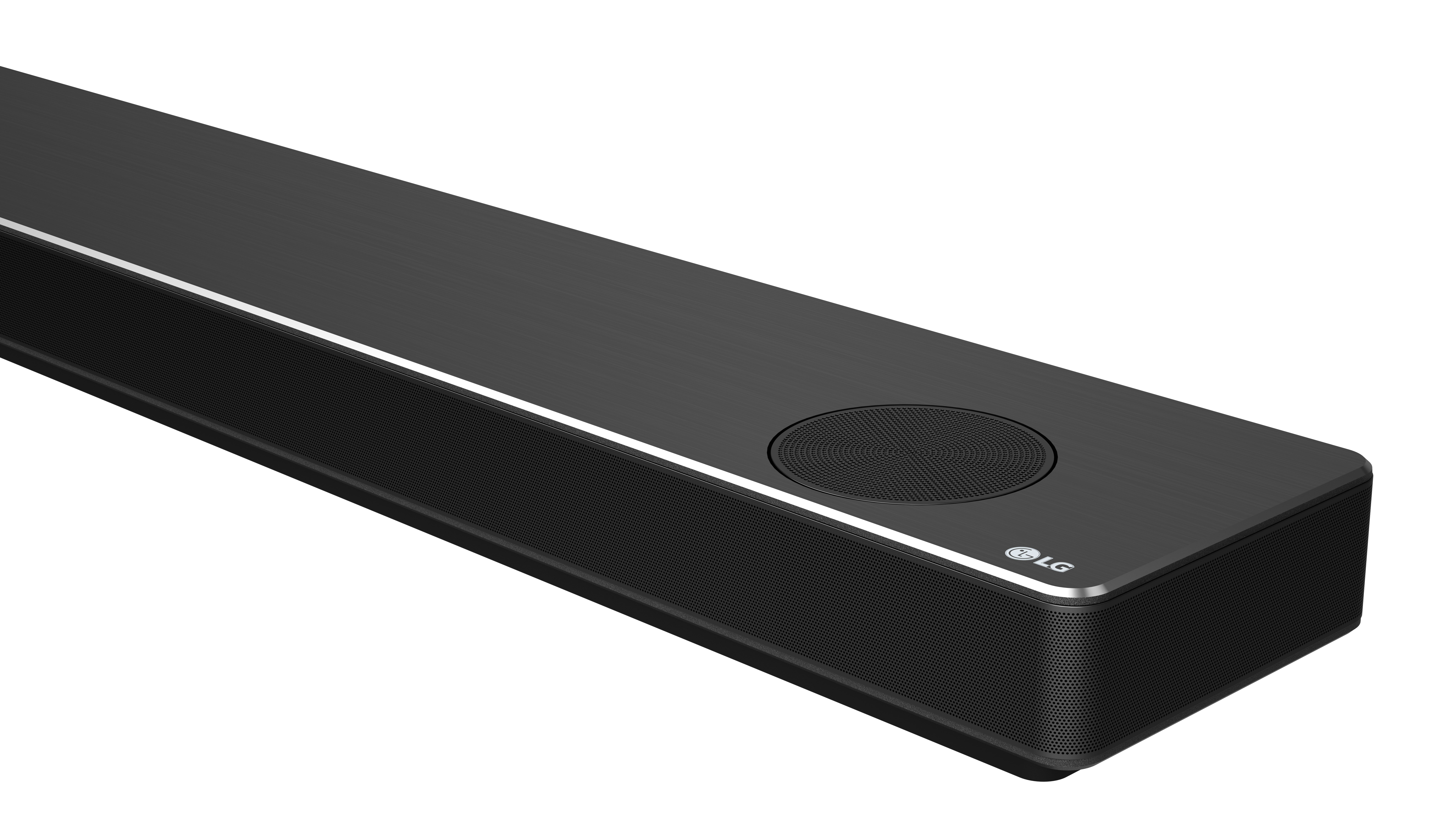
There is actually a two-page chart in LG’s online user’s manual that graphically illustrates what all of the modes do based on the incoming signal type and whether surround is on or off. Ultimately, I could always find a mode and combination that sounded correct, however, I felt like I was frequently hunting through different modes or fiddling depending on the program to find what felt right, often causing my (exasperated) wife to say, “Can we just pick one and be done with it?” (To be fair, after living with the bar for a while and better understanding how the modes work, the fiddling has greatly diminished, however, I still do regularly switch between Standard, Movie, and Music with surround on and off.)
Now, to be clear, all of my qualms and issues disappear when we are talking about how the bar performs when getting Atmos or DTS:X signals. Here it consistently sounded fantastic. Sounds frequently swirled all around the room or were clearly positioned on the ceiling up overhead. The SN11RG did everything you want an Atmos experience to deliver, and it bests any other Atmos
Music mixed in Atmos is in its infancy, but there is a pretty wide variety of options on Tidal that offer Dolby Atmos via AppleTV, and it is fun to listen to different songs/albums, and sometimes you’ll stumble across a really nice mix that makes great use of the added channels. While I think Billie Eilish’s “No Time to Die” is too slow for a James Bond theme, the Atmos mix sounds great, with her haunting voice mixed big and high across the front with the rears and rear heights used for strings and reverb. Post Malone’s “Sunflower” is another song mixed with some aggressive surround effects, including Swae Lee’s vocals mixed strongly bouncing between rear and front channels.
Taylor Swift made her Folklore: The Long Pond Studio Sessions available to Disney+, a stripped down, acoustic presentation of her latest album played “live” for the first time by the album’s collaborators. The Atmos mix played through the SN11RG keeps Taylor’s voice clear and big across the front, while using the height channels to deliver a ton of ambience and really help establish the acoustic characters of the space.
If you haven’t upgraded to the new 4K HDR transfers of The Lord of the Rings and The Hobbit yet, you’re missing out! These films have never looked better, and, thanks to a new Dolby Atmos mix, never sounded better. Even from the opening seconds of Fellowship of the Ring, the SN11RG plunges the room into the atmospheric world of Middle Earth. The opening of The Desolation of Smaug has Thorin Oakenshield walking through the rain, which patters all around the room, but as he steps through the door of The Prancing Pony tavern, you clearly hear rain drops pouring overhead and then receding behind you.
The first race from Ready Player One is one of my Atmos demo go-tos, and the LG totally impressed with how it was able to place images all around the room, behind me, out to the sides, and overhead. Height effects like the biplanes flying, Kong leaping, or other cars crashing and rolling were clearly distinguishable, and totally localizable as occurring from overhead.
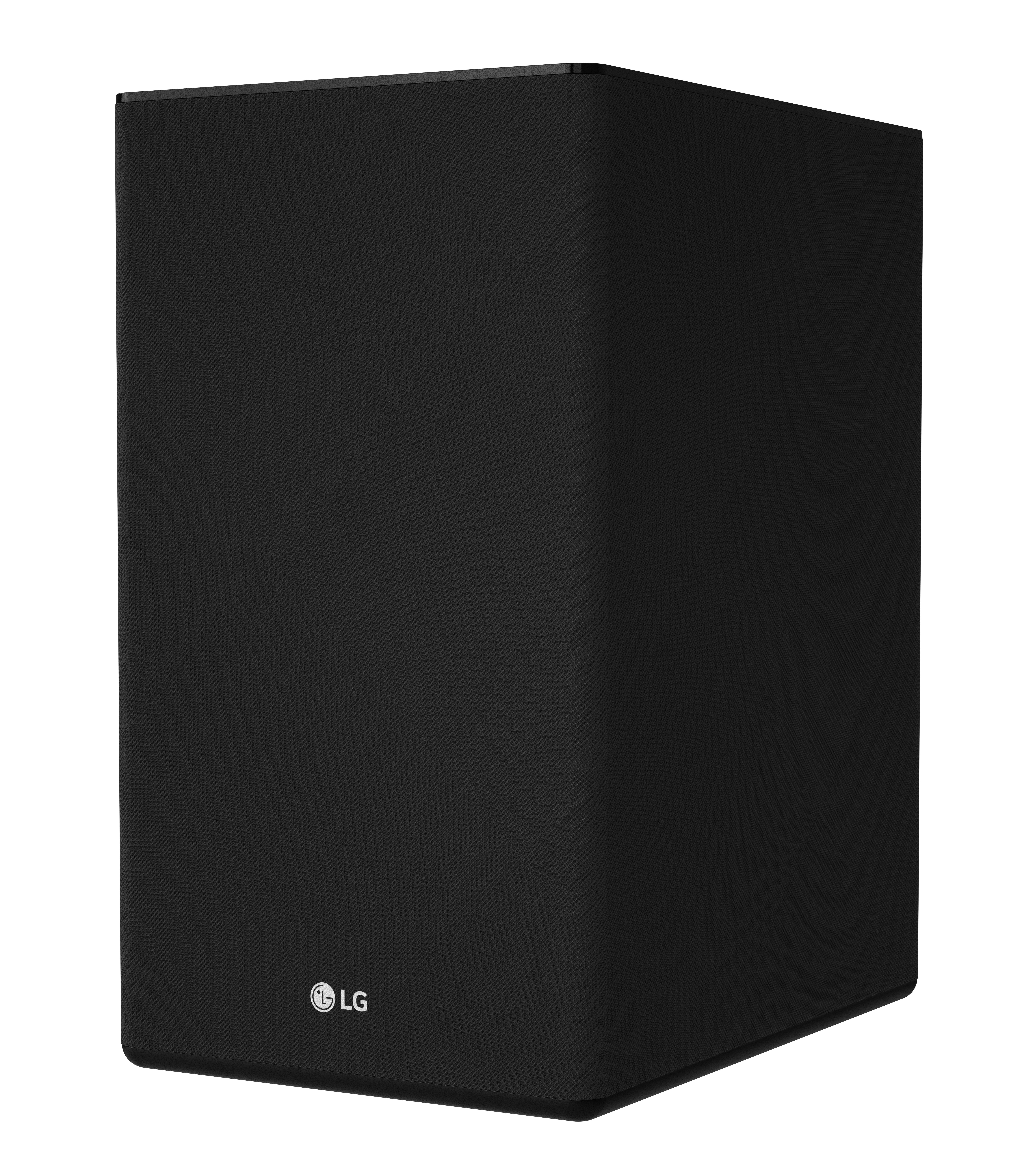
The one place the bar could improve would be in the subwoofer. While it produces decent thump and boom, its 7-inch driver really isn’t enough to deliver truly cinematic low-end, and it doesn’t have a lot of dimension to its sound. Would love to see this get an upgrade to a 10-inch driver, or, better yet, an option to add two subs!
Even with its sound mode foibles, I truly loved LG’s SN11RG. No, it isn’t perfect, and a soundbar will never replace a true multi-speaker surround system, but, damn!, does this thing sound good! For small-to-medium-sized rooms, the SN11RG will deliver immersive surround sound that will entertain and impress, and you couldn’t assemble a surround system that would touch it for ease of use selling for anywhere near its $1500 MAP. The SN11RG should definitely be on your soundbar shortlist for customer’s looking for an Atmos surround solution without a premium price or installation.
800-243-0000; LG.com
Kudos: Incredibly immersive audio with Atmos and DTS:X content; really convincing height channel audio
Concerns: Large size; Google Assistant operation; surround mode hunting
Product Specs:
- 1.4-channel Dolby Atmos/DTS:X streaming soundbar
- Incorporates Meridian Audio Technologies, including “Bass & Space” and “Image Elevation”
- Front bar includes 10 drivers; 40x100mm woofers and 20mm tweeters for each L/C/R channel, 2.5-inch upfiring front heights, and 40x100mm surrounds; Rear speakers include 3-inch woofers and 2.5-inch upfiring drivers; Subwoofer 7-inch driver
- 770 watts total system power; 50 watts for each 11 channels, 220 watts for subwoofer
- 11 a/b/g/n Wi-Fi with Google Assistant, Chromecast, and Bluetooth
- Top-mounted capacitive touch controls for power, source, volume up/down, play/pause, microphone on/off, and Google Assistant on/off
- Inputs: USB, Toslink optical, 2 x HDMI (HDCP 2.3) with 4K HDR and Dolby Vision pass-thru; Output: HDMI (HDCP 2.3) supporting eARC; built-in far-field microphone
Dimensions:
- Bar: 2.5 x 56.8 x 5.7-inches (HxWxD)
- Surrounds: 8.3 x 5.1 x 7.5-inches (HxWxD)
- Sub: 15.4 x 8.7 12.3-inches (HxWxD)

